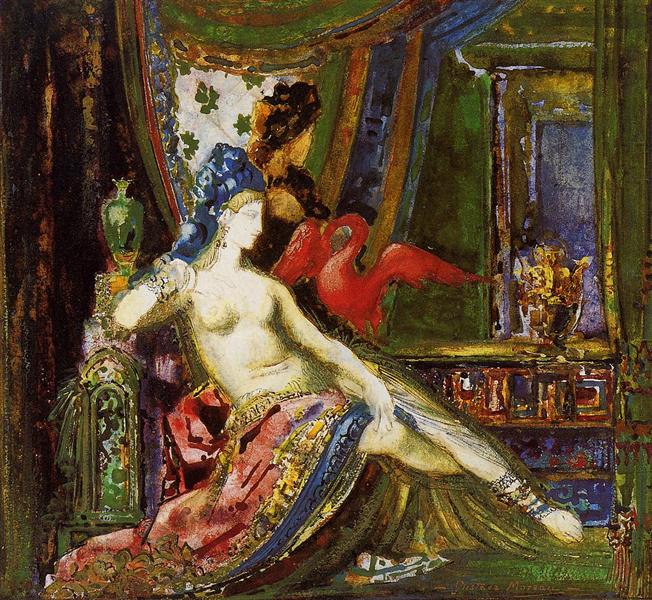Description
Gustave Moreau, an emblematic representative of the French symbolism, surrounds us once again in the shadows of his mysterious narrative with the painting "Dalila", created around 1890. Observing this work, one immediately is submerged in the dream and allegorical universe that Characterizes the production of Moreau. The central figure of the composition is Dalila, a biblical character whose betrayal of Samson has been a source of inspiration for numerous artists throughout history.
The first thing that is perceived when contemplating "Dalila" is the ethereal figure and at the same time of the protagonist. Sitting in a royal position, its silhouette emanates a seductive coldness. With the left hand located near his chest and his view diverted to the right, Dalila does not transmit guilt but a mixture of pride and enigmatism. This detail, represented with the characteristic thoroughness of Moreau, reinforces the duality inherent in the character: deadly beauty and indulgent betrayal.
Moreau uses a rich and saturated color palette, dominated by the gold and blue that confer majesty to the scene. The golden background, which reminds of the Byzantine mosaics, serves to frame and glorify the figure of Dalila, giving an almost divine air. The use of deep blue in its mantle contrasts effectively, highlighting its royalty and coldness.
A notable aspect of this painting is the elaborate use of ornamental details. Moreau, with its tendency to decorative overload, incorporates an profusion of symbolic and floral elements that enrich the composition. These details are not only visual ornaments, but also reinforce the issues of opulence and moral decline, recurring in the painter's work.
The light in Moreau's painting plays a crucial role. In "Dalila", the lighting highlights not only the figure of the woman, but also every fold and ornament of their clothing. The precision with which the textile and jewelry elements are treated denotes the artist's interest in materiality and his ability to transform texture into a visual language rich in meaning. The golden lighting that seems to emanate from behind the protagonist suggests a dark divinity, in contrast to the usual heavenly light in other artistic interpretations of biblical figures.
It is interesting to observe that Moreau, despite being contemporary of impressionism, remains firm in rejection of the principles of this movement. His attention to detail and his preference for the historical, literary and mythological issues are placed by sections of his contemporaries who sought to capture the light and transience of the moment. Instead, Moreau opts for a static and timeless world, more in line with symbolism than with modern concerns.
A look at Dalila's face reveals an affinity with the medieval and Renaissance representations of fatal women. It is a look that seduces and at the same time baffles, a testimony to the power of beauty and betrayal. It is no accident that Moreau chooses this biblical issue; Dalila represents the culmination of many of the painter's obsessions: the femme fatale, the male torment, the destructive power of love.
In short, "Dalila" by Gustave Moreau is an outstanding example of symbolism in painting. Through a meticulous composition and a rich color palette, Moreau manages to encapsulate the moral ambiguity and tragic beauty of its protagonist. Painting is not only a testimony of the artist's technical talent, but also of its ability to deepen the complexities of the human condition, transforming a biblical story into a meditation on power, betrayal and eternal beauty.
KUADROS ©, a famous paint on your wall.
Hand-made oil painting reproductions, with the quality of professional artists and the distinctive seal of KUADROS ©.
Art reproduction service with satisfaction guarantee. If you are not completely satisfied with the replica of your painting, we refund your money 100%.

